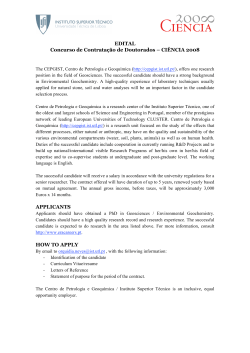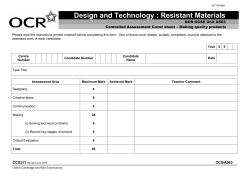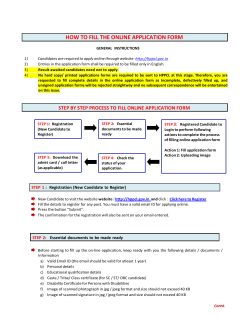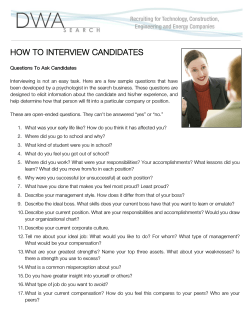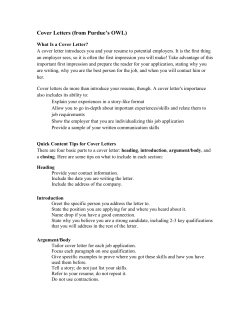
Meet CFUS
February 2008 Meet CFUS Issue: III CFUS Update! Industry: Real Estate Technology : Oracle eBusiness Suite Provided operation and maintenance support for their Oracle eBusiness installation. Services included integration with third-party products, application extensions to handle proprietary data, and end-user training. Industry: Insurance Service: Enterprise Website Implementation Provided corporate identity consulting to re-brand the organization's web presence. Designed, developed, and implemented a fresh and progressive website based on current industry standards and client requirements. Joseph C. (Joe) Hibbitt Principal, President Los Angeles, California How to avoid an IT staffing nightmare As CEO, you're likely convinced that having an IT department in your company is critical, but as far as the task of actually hiring technowizards you've probably happily left that to somebody else. You're not in the HR department, right? Manny Mangahas Principal, VP—East Coast Operations Clifton, Virginia (Washington DC) Burnie Reed Principal, VP—Midwest Operations Dallas, Texas particularly with IT people. Avoid this common problem with a general job description to broadly document your needs. Specify the primary skills required, to ensure the candidate can hit the ground running with little down time. Specify the secondary skills required. For example, if they know cost acBut when your computer or the counting in the consumer elecnetwork goes down, you're go- tronic industry, they may also have the ability to analyze ing to be in the same boat as across business functions. Specevery other employee - helplessly reliant on the folks in the ify precisely what you expect IT department to fix whatever's the candidate to do. This is critical; leading placement agencies ailing. But what if the wrong people have been hired? What if aim to find candidates that have been there, done that. But that's they're not really qualified for difficult when managers don't the specific tasks needed to specify what they expect the complete your company's candidate to do timely projects? The costs of the ensuing delays could be Validate the candidate's qualifiastronomical. So how do you cations by asking the right quesmake sure you find the right person, particularly in an envi- tion - again. The difference beronment where there seem to be tween finding the right person a million other companies look- and the almost-right person is a matter of asking the right quesing for people with the same capabilities and expertise? Here tions and then reformulating the same question to check your are some tips. answers. In this way you have a much better chance of correctly Understand your need. Too identifying a potential candioften, managers searching for temporary help formulate only date's real skills, not just giving the vaguest of job descriptions, them a slow pitch they can hit, and allowing them to tell you what you want to hear. Ask the same question from three or four different angles. The end goal is to nail down a more exact understanding of the candidate's skill sets. Without going to this extra trouble there's a good chance a candidate can be placed in a job situation that doesn't quite match your needs. And that's what you want to avoid. Understand the HR/IT communication gap. If you didn't think there was a communication problem in your organization, that may be the problem. Because in eight of 10 larger companies with well-developed HR and IT departments, the HR staff honestly doesn't have a clear picture of the needs of the IT department. Just look at how many IT candidates get hired within your own company as contractors or permanent hires, with IT managers bypassing HR. The problem arises because HR too often focuses on the candidate's list of skills, while failing to match what the candidate has done and what the manager expects the candidate to do. February 2008 Say you're looking for a carpenter to build a house. You have two candidates who both have experience using a saw, a hammer, and a drill. One has employed those skills installing windows, doors, building fences, and laying tile. The second has employed the same skills building houses. Which one would you want to build your new house? Check references - always. This step sounds so basic, and yet, too often, it doesn't get done adequately. Contrary to popular belief you'll find most former employers surprisingly willing to pass along their honest recommendations, or concerns. If you're using the services of a placement consultant, you'll want to make certain they check all refer- Issue: III ences for the past several years. Personally, I attempt to obtain three references for all contractors and permanent hires - two managers and one peer. dates who have been screened by the placement firm first. Have the firm provide proof of the internal interview by submitting their interview documentation. Before deciding on a candidate, have the firm perform reference checks. And make sure the firm has a mechaGet your money's worth from a placement firm. Companies spend a lot of money hiring nism for evaluating the candidate's performplacement firms to find qualified IT person- ance once they're hired. nel, but sometimes they're left wondering what they spent the money for. To prevent Managing and integrating technology perthat, don't deal with placement firms that sonnel and IT managers is hard enough. don't do the up front work. Check the referMake your job easier by taking the time to ences of the placement firm, companies choose the right people for the job right from they're currently doing business with. Don't the start. Remember - technology is only as initiate a search until you're sure the placegood as the people who make it work. ment consultant understands your requirements entirely. Interview only those candi- Spending wisely during down times Conventional wisdom suggests that during a recession, companies should preserve cash wherever possible. Of course, this “wisdom” ignores two very important facts. First, if everyone follows that advice, then recession will quickly turn to depression as demand for goods and services evaporates. Second, and most importantly, recessions tend to drive prices downward, resulting in opportunities to invest in infrastructure, cost-saving, or productivity assets at a significant discount. software developers. They can load their development environment or code/debug environment on one screen and then work with the program output on the other. They can also use help files or training materials on one screen and the programs on the other. (I prefer to have my e-mail loaded continuously on one of the screens while I’m working on software on the other.) Many customer areas—finance, customer service, help desk—may also benefit from the extra virtual workspace provided by a second monitor. Making these kinds of investments now will They can dedicate the space on one monitor to their major work area and dedicate the make your company even more profitable when the economy turns around. Here are the other to their productivity applications; e.g., Word and Outlook. four most common investment ideas I’ve collected through discussions with CIOs and Adding multiple-monitor capability is very technical managers. inexpensive. You can purchase additional 17-inch monitors for around $150. Many 1. Dual displays corporations have excess monitors from Although once considered a perk because of situations in which their companion PCs cost, many companies have found that outfitwere cycled out, but the monitors still had a ting key technical or operational employees useful life. If you have desktop or tower syswith multiple displays dramatically increases tems, you can get a second display card for productivity. about $75 or a dual-display graphics card for about $150. And modern operating systems Ideally, you should equip your technical have support for multiple displays built in. team with laptops whose monitor outputs Windows 2000 and Windows XP support up will drive both the internal LCD display and to nine monitors out of the box. Many duala separate monitor. This is especially true for display cards have drivers for Windows 98 as well. 2. Increase workstation memory Over the last year, memory prices have dropped precipitously. But the decrease in supply of higher-speed memory to match new Intel processors has already prompted prices to rise. You should expect costs to rise over the next 12 months and for memory to cost twice what it is now, as new, high-speed memory formats (DDR and Rambus) become dominant and older excess inventories of SDRAM become exhausted. Most engineering and development managers I have spoken with recommend that technical personnel and power users have a minimum of 512 MB of RAM and that others should have a minimum of 256 K. If you have the cash to do it, now’s the best time to buy. 3. Go mobile Fueled by wide acceptance and rock-bottom prices, many companies have begun cashing in on the 802.11b wireless craze. Working with wireless and portable equipment makes your technical team much more efficient. They can take their work with them to a comrade’s desk, a meeting room, or home. February 2008 Having a laptop lets them move around, yet it’s a wireless connection that lets them stay connected. And now that many homes are equipped with high-speed cable or DSL access and wireless connectivity, you can allow your employees to connect from home using a VPN. 4. Virtual machine technology As single processors surpass the speed of last year's multiprocessor machines, they have extra horsepower available for other tasks. In fact, they have the power to become multiple, simultaneous machines. Software from VMware and Connectix allows any speedy PC with a lot of memory to appear to the user Using the VPN also allows you to get around as several machines sharing a single keythe number one problem with accessing wire- board and monitor. less networks from home: the weakness of the Wired Equivalent Privacy (WEP), an There are two key scenarios in which you 802.11 security protocol for wireless netmay want to make an immediate investment works. The WEP encryption method is dein this technology. First, when used as a misigned to provide the "equivalent" security gration technology, these packages allow you available in wired networks. The comto run legacy DOS, Win32, and Windows pressed, encrypted data passing through the 95/98 programs in separate virtual machines VPN channel cannot be compromised by (VMs) when they don’t run properly on Winexternal sniffers. dows 2000 or Windows XP. You can even Issue: III use server-based VM technology (like VMware’s GSX or ESX servers) to centralize all of the legacy programs and serve them to clients using remote control and management software. Second, you may want to invest in VM technology for testing of engineering scenarios or development environments. The ability to simulate these environments using VM technology can save companies thousands of dollars on both equipment costs and the cost of the time to configure the equipment for testing. Although the cost of these products has remained fairly constant, the price of the hardware necessary to use them effectively (faster processors, lots of memory) is lower than it’s ever been. Working Out at Work It's hard to find time to exercise, but now you don't have that excuse anymore. You may think you don't have time to workout at work, but there are opportunities everywhere if you pay attention. All it takes is a little planning and some inspiration to squeeze in the exercise all day long. if you just swing your arms or take a deep breath, you'll feel more alert. ● Use the restroom on another floor and take the stairs ● Use a pedometer and keep track of how many steps you take. Aim for 6,000 to 10,000 steps a day. ● Leave something important in your car (your lunch, your briefcase, etc.) so you have The Basics to run out to get it (and take the stairs) You already know the drill about being more ● Deliver documents or messages to coactive at work. Take the stairs whenever you workers in person rather than by email can, park further away from the door, etc. ● Go to the mall for lunch and park on the But, there are some other things you may not opposite end of the food court. Don't forget have considered. to buy something healthy. ● Sit on an exercise ball instead of a chair. ● Get a headset for your phone so you can This will strengthen your abs and back and move around while you talk. you'll work on your posture without even trying. Be creative. Any movement is better than ● Set an alarm to go off every hour to renone, so don't feel like you have to do sprints mind you to stand up and move around. Even all day long. Adding short bouts of exercise Contact CFUS (corporate) The CFUS Corporation * 4859 West Slauson Ave. Suite 219 * Los Angeles, California 90056 323.298.8502—office * 310.388.5988—fax * info@cfus.com * http://www.cfus.com Story Credits: http://www.zdnetasia.com/insight/business/0,39051970,39045632,00.htm http://findarticles.com/p/articles/mi_m4070/is_1999_Oct/ai_57590679 http://exercise.about.com/cs/fittingitin/a/officeexercise.htm © The CFUS Corporation – All Rights Reserved throughout the day will help you burn more calories and will also reduce stress so you can easily smile at your boss when she piles more work on you. Exercise Equipment If you have your own office, consider keeping a resistance band, ankle weights and even a couple of sets of dumbbells in your desk drawer. You can squeeze in some quick upper body exercises while you're on the phone. If you work in a cubicle or don't want people to see you exercising at your desk, all you really need is a chair and a couple of large, full water bottles you can use for any dumbbell exercise.
© Copyright 2025


